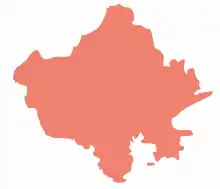Jaisalmer
Jaisalmer ![]() pronunciation , nicknamed "The Golden city", is a city in the Indian state of Rajasthan, located 575 kilometres (357 mi) west of the state capital Jaipur. The town stands on a ridge of yellowish sandstone and is crowned by the ancient Jaisalmer Fort. This fort contains a royal palace and several ornate Jain temples. Many of the houses and temples of both the fort and of the town below are built of finely sculptured sandstone. The town lies in the heart of the Thar Desert (the Great Indian Desert) and has a population, including the residents of the fort, of about 78,000. It is the administrative headquarters of Jaisalmer District. Jaisalmer was once the capital of Jaisalmer State.
pronunciation , nicknamed "The Golden city", is a city in the Indian state of Rajasthan, located 575 kilometres (357 mi) west of the state capital Jaipur. The town stands on a ridge of yellowish sandstone and is crowned by the ancient Jaisalmer Fort. This fort contains a royal palace and several ornate Jain temples. Many of the houses and temples of both the fort and of the town below are built of finely sculptured sandstone. The town lies in the heart of the Thar Desert (the Great Indian Desert) and has a population, including the residents of the fort, of about 78,000. It is the administrative headquarters of Jaisalmer District. Jaisalmer was once the capital of Jaisalmer State.
Jaisalmer | |
|---|---|
City | |
| Jaisalmer | |
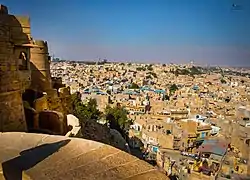 City view from the Jaisalmer Fort | |
| Nickname(s): The Golden city | |
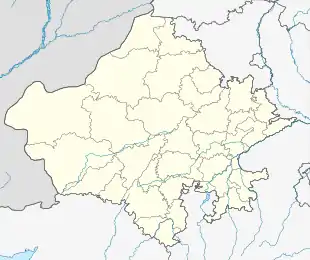 Jaisalmer Location in Rajasthan, India  Jaisalmer Jaisalmer (India) 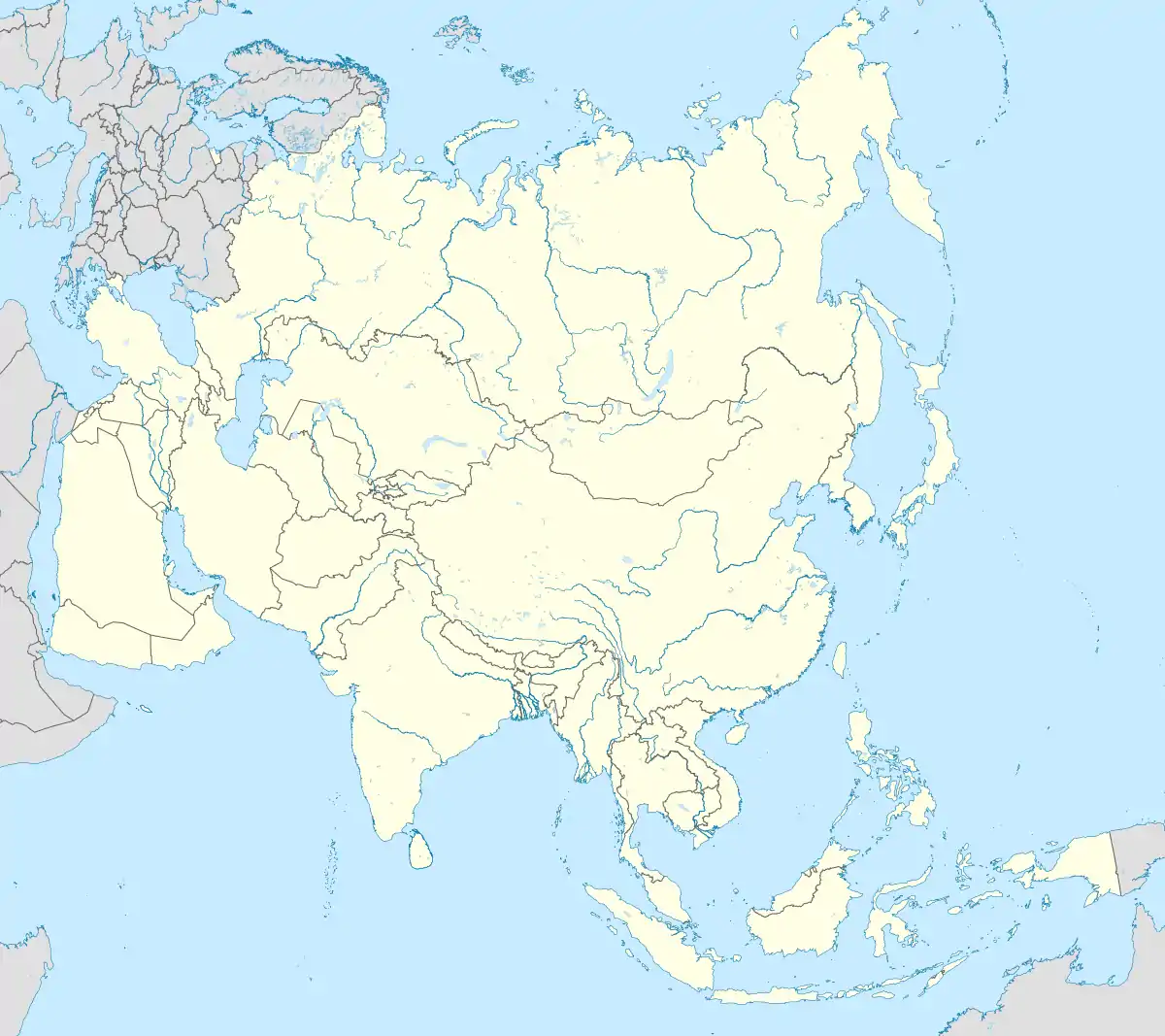 Jaisalmer Jaisalmer (Asia) | |
| Coordinates: 26.913°N 70.915°E | |
| Country | |
| State | Rajasthan |
| District | Jaisalmer |
| Founded by | Rawal Jaisal |
| Government | |
| • Member of Parliament | Kailash Choudhary |
| • Member of Legislative Assembly | Rooparam |
| • District Collector & District Magistrate | Ashish Modi, IAS |
| • Superintendent of Police | Dr Ajay Singh, IPS[1] |
| Area | |
| • Total | 5.1 km2 (2.0 sq mi) |
| Elevation | 225 m (738 ft) |
| Population (2011) | |
| • Total | 65,471 |
| Languages | |
| • Official | Hindi and Rajasthani |
| Time zone | UTC+5:30 (IST) |
| PIN | 345 001 |
| Telephone code | 02992 |
| ISO 3166 code | RJ-IN |
| Vehicle registration | RJ-15 |
| Website | jaisalmer |
| Official name | Jaisalmer Fort |
| Part of | Hill Forts of Rajasthan |
| Criteria | Cultural: (ii)(iii) |
| Reference | 247rev-006 |
| Inscription | 2013 (37th session) |
| Area | 8 ha (0.031 sq mi) |
| Buffer zone | 89 ha (0.34 sq mi) |
Origin of name
Jaisalmer is named after Rawal Jaisal, a Bhati ruler who founded the city in 1156 AD.[2] Jaisalmer means the Hill Fort of Jaisal. Jaisalmer is sometimes called the "Golden City of India" because the yellow sandstone used throughout the architecture of both the fort and the town below, imbues both with a certain golden-yellow light.
Location
It is the largest district of Rajasthan and 3rd largest Town by territorial region in the country, hugged on the west & south-west by the Pakistani border. The length of the international border attached to Jaisalmer District is 464 km (288 mi). It is located 790 kilometres away from the national capital Delhi.
Geography and climate
Jaisalmer, being an arid desert region, is prone to extremes in terms of temperature. The temperature varies greatly from day to night in both summer and winter. The maximum summer temperature is around 49 °C (120 °F) while the minimum is 25 °C (77 °F). The maximum winter temperature is usually around 23.6 °C (74.5 °F) and the minimum is 5 °C (41 °F). The average rainfall is 209.5 millimetres (8.25 in).[3] Highest ever recorded temperature was 50.0 °C (122.0 °F);[4] the lowest ever recorded temperature being −5.9 °C (21.4 °F).[5] Temperature of up to 52.4 °C (126.3 °F) have been recorded near the international border close to Pakistan, but standard conditions of this temperature recording remain unverified.[6]
| Climate data for Jaisalmer (1981–2010, extremes 1948–2012) | |||||||||||||
|---|---|---|---|---|---|---|---|---|---|---|---|---|---|
| Month | Jan | Feb | Mar | Apr | May | Jun | Jul | Aug | Sep | Oct | Nov | Dec | Year |
| Record high °C (°F) | 35.8 (96.4) |
37.8 (100.0) |
42.3 (108.1) |
45.8 (114.4) |
48.0 (118.4) |
49.2 (120.6) |
47.0 (116.6) |
43.3 (109.9) |
43.3 (109.9) |
42.2 (108.0) |
38.8 (101.8) |
34.4 (93.9) |
49.2 (120.6) |
| Average high °C (°F) | 23.8 (74.8) |
27.3 (81.1) |
33.3 (91.9) |
39.1 (102.4) |
41.9 (107.4) |
40.9 (105.6) |
38.1 (100.6) |
36.6 (97.9) |
37.1 (98.8) |
36.5 (97.7) |
31.3 (88.3) |
25.4 (77.7) |
34.3 (93.7) |
| Average low °C (°F) | 8.6 (47.5) |
12.4 (54.3) |
17.6 (63.7) |
23.5 (74.3) |
26.4 (79.5) |
27.6 (81.7) |
27.0 (80.6) |
25.9 (78.6) |
25.0 (77.0) |
21.8 (71.2) |
15.9 (60.6) |
10.5 (50.9) |
20.3 (68.5) |
| Record low °C (°F) | −6.1 (21.0) |
−4.9 (23.2) |
2.0 (35.6) |
10.6 (51.1) |
15.1 (59.2) |
17.2 (63.0) |
20.1 (68.2) |
19.1 (66.4) |
12.3 (54.1) |
6.7 (44.1) |
1.9 (35.4) |
−4.4 (24.1) |
−5.9 (21.4) |
| Average rainfall mm (inches) | 1.3 (0.05) |
5.2 (0.20) |
3.3 (0.13) |
7.2 (0.28) |
7.2 (0.28) |
21.0 (0.83) |
59.2 (2.33) |
72.2 (2.84) |
19.3 (0.76) |
3.0 (0.12) |
0.7 (0.03) |
2.1 (0.08) |
201.6 (7.94) |
| Average rainy days | 0.2 | 0.6 | 0.4 | 0.5 | 0.6 | 1.2 | 3.3 | 3.2 | 1.4 | 0.3 | 0.1 | 0.2 | 12.0 |
| Average relative humidity (%) (at 17:30 IST) | 31 | 26 | 22 | 19 | 21 | 29 | 45 | 50 | 39 | 26 | 27 | 31 | 31 |
| Source: India Meteorological Department[7][8] | |||||||||||||
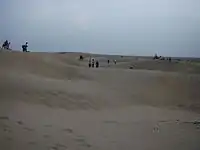 Sand dunes near Jaisalmer.
Sand dunes near Jaisalmer.
Economy
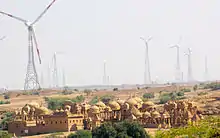
Tourism is a major industry in Jaisalmer. The Government of India initiated departmental exploration for oil in 1955–56 in the Jaisalmer area.[9] Oil India Limited discovered natural gas in 1988 in the Jaisalmer basin.[10]
Musicians and dancers are also a major cultural export from Jaisalmer to the rest of the world. Manganiyar musicians have played the world over, and Queen Harish,[11] the dancing desert drag queen, has toured the world over and has featured in international movies.
Jaisalmer is also known for its leather messenger bags, made from wild camels native to the area.
Transport
Jaisalmer is connected to the rest of Rajasthan by buses provided by Rajasthan State Transport Corporation as well as other private bus operators.
Jaisalmer Airport is located 17 kilometres southeast of Jaisalmer. Flights serve Mumbai, Delhi, Jaipur, Ahmedabad, Surat and Jodhpur.
Jaisalmer railway station runs daily trains between Jaisalmer and Jaipur, through which it is connected to Delhi and other cities all over India. This station comes under Jodhpur (JU) division of the Northwestern Railway (NWR). Additionally, there exists a luxury tourist train known as Palace On Wheels, which covers the major tourist destinations of Rajasthan, including Jaisalmer.
Places of interest
Jaisalmer Fort
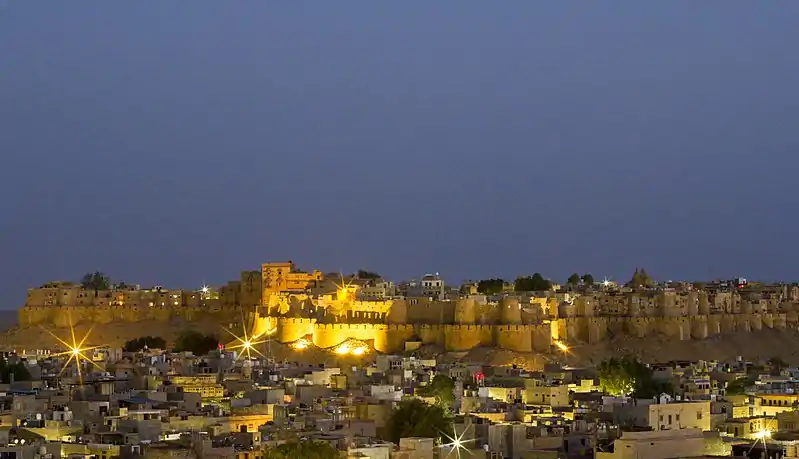
Built in 1156 by the Bhati Rajput ruler Jaisal, Jaisalmer Fort, situated on Meru Hill and named as Trikoot Garh has been the scene of many battles. Its massive sandstone walls are a tawny lion colour during the day, turning to a magical honey-gold as the sun sets. The famous Indian film director Satyajit Ray wrote a detective novel and later turned it into a film − Sonar Kella (The Golden Fortress) which was based on this fort. About a quarter of city's population still live inside the fort. The main attractions inside the fort are: Raj Mahal (Royal palace), Jain temples and the Laxminath temple.
Jain heritage of Jaisalmer
Jaisalmer has been enriched by its Jain community, which has adorned the city with beautiful temples, notably the temples dedicated to the 16th Tirthankara, Shantinath, and 23rd Tirthankara, Parshvanath.
There are seven Jain temples in total which are situated within the Jaisalmer fort built during the 12th and 15th centuries. Among these temples, the biggest is the Paraswanath Temple; the others are Chandraprabhu temple, Rishabdev temple, Shitalnath Temple, Kunthunath Temple, and Shantinath Temple. Known for their exquisite work of art and architecture that was predominant in the medieval era the temples are built out of yellow sandstone and have intricate engravings on them.
Jaisalmer has some of the oldest libraries of India which contain rarest of the manuscripts and artefacts of Jain tradition. There are many pilgrimage centres around Jaisalmer such as Lodhruva (Lodarva), Amarsagar, Brahmsar and Pokharan.
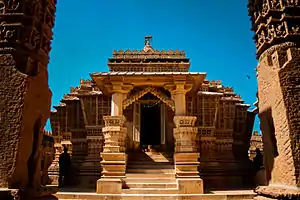
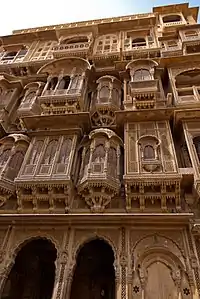 Patwon Ji Ki Haveli
Patwon Ji Ki Haveli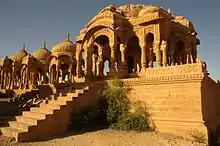
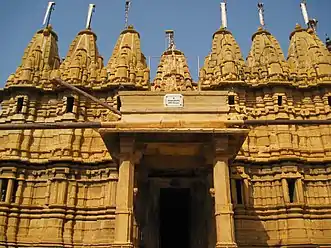 Chandraprabhu Jain Temple inside the Jaisalmer Fort
Chandraprabhu Jain Temple inside the Jaisalmer Fort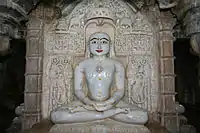 Chandraprabhu idol inside Chandraprabhu Jain Temple of Jaisalmer Fort
Chandraprabhu idol inside Chandraprabhu Jain Temple of Jaisalmer Fort Jain Temple inside the Jaisalmer Fort
Jain Temple inside the Jaisalmer Fort Parshvantha, Lodhruva Jain Temple
Parshvantha, Lodhruva Jain Temple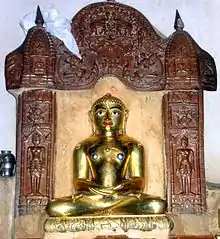 Shantinatha, Lodhruva Jain Temple
Shantinatha, Lodhruva Jain Temple Ceiling of Jain temple inside the Jaisalmer Fort
Ceiling of Jain temple inside the Jaisalmer Fort Carving on the wall of Jain Temple, Jaisalmer Fort
Carving on the wall of Jain Temple, Jaisalmer Fort
Museums
- Desert Culture Centre & Museum
- Jaisalmer Folklore Museum
- Government Museum
- Jaisalmer Fort Palace Museum
- Jaisalmer War Museum
- Akal Fossil Park Museum
- Cactus Park Museum, Kuldhara
- Tanot Museum
Other
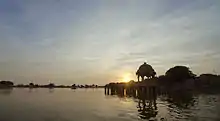
Ramdevra a village in Jaisalmer is named after Baba Ramdevji, a Tanwar Rajput and a saint who took Samādhi in 1384 CE, at the age of 33 years. He is worshiped today by many social groups of India as Ishta-deva.
.jpg.webp)
- Gadsisar Lake – Excavated in 1367 by Rawal Gadsi Singh, it is a scenic rainwater lake surrounded by the small temples and shrines of Amar Sagar. Earlier, this lake was used to be the main water source of Jaisalmer. Due to an increased water demand for agriculture, the lake is increasingly threatened to dry out.[12]
In neighbourhood
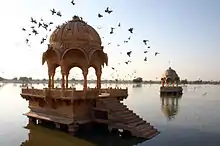
- Bada Bagh, a complex with chhatris of Jai Singh II (d. 1743) and subsequent Maharajas of Jaisalmer
- Lodhruva
- Desert National Park
- Bhaniyana
- Lanela
- Battle of Longewala point
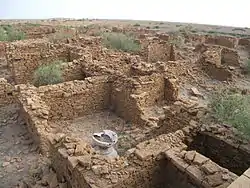
Desert festival
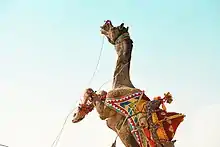
Desert Festival of Jaisalmer is the most awaited and famous cultural and colourful event of Rajasthan. Camel races, Turban-tying and Mr. Desert competitions are organised. It is held in the month of February every year. The festival showcases Rajasthani folk songs and dance and it is very attractive to foreign tourists. Gair and Fire dancers which are the major attraction of the Jaisalmer desert festival celebrations. This is the best time to visit Jaisalmer to witness performing arts like Kalbelia dances and folk songs and music.
See also
- Paramara, Dalvi-Deshmukh of Nasik originating from Jaisalmer
- Indira Gandhi Canal
- Pokhran
- Baba Ramdevji, the 14th century ruler
- Tanot Mata
- Kuldhara
Cultural references
- Gupi Gayen Bagha Bayen (1969), a Bengali film, directed by Satyajit Ray, was partly shot at Jaisalmer Fort.
- Sonar Kella (1974) (Golden Fortress) Satyajit Ray's Bengali film, based on his eponymous novel featuring his creation, the detective Feluda, was based in Jaisalmer and surrounding areas.[13][14]
- Hothat Brishti, a Bengali film was shot in Jaisalmer.
- Goray Gondogol (2012), a Bengali film was partly shot in Jaisalmer.
- Kishore Kumar Junior (2018), a Bengali film was partly shot in Jaisalmer.
- Soul of Jaisalmer (Hindi non-feature film 2016) made by Abenezer Inder. This film is based on traditional water step well of Jaisalmer and was filmed in Gadsisar, Amar Sagar, Bada Bagh and many more far location of Jaisalmer.
 Full shot of documentary film Soul of Jaisalmer (2016)
Full shot of documentary film Soul of Jaisalmer (2016) Shot of documentary film Soul of Jaisalmer (2016)
Shot of documentary film Soul of Jaisalmer (2016)
Further reading
- Bhati, Hari Singh. 2002. ANNALS OF JAISALMER: A Pre-Mediaeval History. Kavi Prakashan, Bikaner.
- Gahlot, Sukhvirsingh. 1992. RAJASTHAN: Historical & Cultural. J. S. Gahlot Research Institute, Jodhpur.
- Somani, Ram Vallabh. 1993. History of Rajasthan.
- Tod, James & Crooke, William. 1829. Annals & Antiquities of Rajasthan or the Central and Western Rajput States of India. 3 Vols. Reprint: Low Price Publications, Delhi. 1990. ISBN 81-85395-68-3 (set of 3 vols.)
References
- "Administration". jaisalmer.rajasthan.gov.in. Retrieved 23 October 2020.
- Balfour, Edward (1885). The encyclopædia of India and of Eastern and Southern Asia. Original from Oxford University: B. Quaritch. p. 406.
- "India Meteorological Department – Weather Information for Jaisalmer". Worldweather.wmo.int. Retrieved 12 October 2012.
- "Border areas in Jaisalmer boil at 50°C, no respite in city". The Times of India. 27 May 2010.
- "JAISALMER". Archived from the original on 26 December 2009. Retrieved 23 December 2009.
- Singh, Anuradha (2 May 2016). "Blistering Heat Wave Continues Across India; Jaisalmer Swelters At 52.4 Degrees". Topyaps.com. Retrieved 5 August 2016.
- "Station: Jaisalmer Climatological Table 1981–2010" (PDF). Climatological Normals 1981–2010. India Meteorological Department. January 2015. pp. 345–346. Archived from the original (PDF) on 5 February 2020. Retrieved 20 January 2021.
- "Extremes of Temperature & Rainfall for Indian Stations (Up to 2012)" (PDF). India Meteorological Department. December 2016. p. M181. Archived from the original (PDF) on 5 February 2020. Retrieved 20 January 2021.
- "2nd Five Year Plan". Archived from the original on 14 April 2006. Retrieved 30 March 2006.
- "Rajasthan Exploration Project (RP)". Archived from the original on 30 June 2006. Retrieved 30 January 2021.
- Sandip Roy, Special to The Chronicle (5 July 2008). "Queen H A R I S H". Queen-harish.blogspot.com. Retrieved 19 August 2012.
- "Jaisalmer, Rajasthan - Don't Complain Travel". Dont-complain.com. 6 March 2014. Retrieved 15 September 2018.
- "Sonar Qila". Financial Express. 9 January 2004. Retrieved 30 January 2021.
- "Jaisalmer Photos". Archived from the original on 18 December 2012. Retrieved 27 December 2019.
External links
| Wikimedia Commons has media related to: |
 Jaisalmer travel guide from Wikivoyage
Jaisalmer travel guide from Wikivoyage Geographic data related to Jaisalmer at OpenStreetMap
Geographic data related to Jaisalmer at OpenStreetMap- . Encyclopædia Britannica (11th ed.). 1911.
